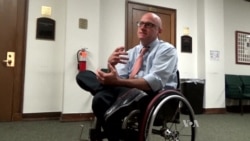ScienceRocks
Democrat all the way!
- Banned
- #1
Walking and Running Again After Spinal Cord Injury
ScienceDaily (May 31, 2012) Rats with spinal cord injuries and severe paralysis are now walking (and running) thanks to researchers at EPFL. Published in the June 1, 2012 issue of Science, the results show that a severed section of the spinal cord can make a comeback when its own innate intelligence and regenerative capacity is awakened. The study, begun five years ago at the University of Zurich, points to a profound change in our understanding of the central nervous system. According to lead author Grégoire Courtine, it is yet unclear if similar rehabilitation techniques could work for humans, but the observed nerve growth hints at new methods for treating paralysis.
"After a couple of weeks of neurorehabilitation with a combination of a robotic harness and electrical-chemical stimulation, our rats are not only voluntarily initiating a walking gait, but they are soon sprinting, climbing up stairs and avoiding obstacles when stimulated," explains Courtine, who holds the International Paraplegic Foundation (IRP) Chair in Spinal Cord Repair at EPFL.
Waking up the spinal cord
It is well known that the brain and spinal cord can adapt and recover from moderate injury, a quality known as neuroplasticity. But until now the spinal cord expressed so little plasticity after severe injury that recovery was impossible. Courtine's research proves that, under certain conditions, plasticity and recovery can take place in these severe cases -- but only if the dormant spinal column is first woken up.
To do this, Courtine and his team injected a chemical solution of monoamine agonists into the rats. These chemicals trigger cell responses by binding to specific dopamine, adrenaline, and serotonin receptors located on the spinal neurons. This cocktail replaces neurotransmitters released by brainstem pathways in healthy subjects and acts to excite neurons and ready them to coordinate lower body movement when the time is right.
Five to 10 minutes after the injection, the scientists electrically stimulated the spinal cord with electrodes implanted in the outermost layer of the spinal canal, called the epidural space. "This localized epidural stimulation sends continuous electrical signals through nerve fibers to the chemically excited neurons that control leg movement. All that is left was to initiate that movement," explains Rubia van den Brand, contributing author to the study.
Walking and running again after spinal cord injury
ScienceDaily (May 31, 2012) Rats with spinal cord injuries and severe paralysis are now walking (and running) thanks to researchers at EPFL. Published in the June 1, 2012 issue of Science, the results show that a severed section of the spinal cord can make a comeback when its own innate intelligence and regenerative capacity is awakened. The study, begun five years ago at the University of Zurich, points to a profound change in our understanding of the central nervous system. According to lead author Grégoire Courtine, it is yet unclear if similar rehabilitation techniques could work for humans, but the observed nerve growth hints at new methods for treating paralysis.
"After a couple of weeks of neurorehabilitation with a combination of a robotic harness and electrical-chemical stimulation, our rats are not only voluntarily initiating a walking gait, but they are soon sprinting, climbing up stairs and avoiding obstacles when stimulated," explains Courtine, who holds the International Paraplegic Foundation (IRP) Chair in Spinal Cord Repair at EPFL.
Waking up the spinal cord
It is well known that the brain and spinal cord can adapt and recover from moderate injury, a quality known as neuroplasticity. But until now the spinal cord expressed so little plasticity after severe injury that recovery was impossible. Courtine's research proves that, under certain conditions, plasticity and recovery can take place in these severe cases -- but only if the dormant spinal column is first woken up.
To do this, Courtine and his team injected a chemical solution of monoamine agonists into the rats. These chemicals trigger cell responses by binding to specific dopamine, adrenaline, and serotonin receptors located on the spinal neurons. This cocktail replaces neurotransmitters released by brainstem pathways in healthy subjects and acts to excite neurons and ready them to coordinate lower body movement when the time is right.
Five to 10 minutes after the injection, the scientists electrically stimulated the spinal cord with electrodes implanted in the outermost layer of the spinal canal, called the epidural space. "This localized epidural stimulation sends continuous electrical signals through nerve fibers to the chemically excited neurons that control leg movement. All that is left was to initiate that movement," explains Rubia van den Brand, contributing author to the study.
Walking and running again after spinal cord injury




